
你有没有想过,为什么最近两年冒出来的AI消费级产品,能在不到两年时间里就从零增长到数百万用户,年收入突破1亿美元?这种增长速度在AI之前几乎是不可想象的。表面上看,这是因为分发速度更快了,用户平均收入更高了。但我发现一个更深层的变化被大多数人忽略了:AI彻底改变了消费级软件的收入留存模式。
最近读到a16z合伙人Olivia Moore的一篇分析文章《The Great Expansion: A New Era of Consumer Software》,她把这种现象称为"Great Expansion"(大扩张),我觉得她抓住了一个非常关键的趋势。在深入思考这个观点后,我发现这不仅仅是商业模式的调整,而是整个消费级软件行业游戏规则的根本性变革。我们正在目睹一个历史性转折点:消费级软件公司不再需要与用户流失作斗争,而是可以依靠用户价值的持续扩张来实现增长。消费级市场和企业市场在某种意义上界限正在逐渐变得模糊
这种变化的影响是巨大的。传统消费级软件公司每年都要花费大量精力和资金来替换流失的用户,仅仅是为了维持现状。而现在,那些抓住了AI机会的公司发现,他们的每一批用户不仅不会流失价值,反而会随着时间推移贡献更多收入。这就像是从一个漏水的桶变成了一个不断膨胀的气球,增长模式完全不同了。
从这个角度分析,我个人认为这是出海公司的巨大机会所在,因为消费级的产品就可以借助PLG来实现增长和营收,完美避开了华人团队很难在海外SLG这一块短板。虽然是做企业市场,但整个增长模式是跟C端产品类似的方式。在这点上,我个人感同身受,我自己的项目目前已经上线跑了一个月,完全面向企业的B端Vibe coding产品,但靠PLG的方式获客增长,拿到了不错的数据反馈。
传统模式的根本缺陷
让我们先回顾一下AI之前的消费级软件是怎么赚钱的。Moore在她的分析中提到了两种主要模式,我觉得她的总结很准确。第一种是广告驱动模式,主要用于社交应用,直接与使用量挂钩,因此通常每个用户的价值在时间上是平坦的。Instagram、TikTok、Snapchat都是这种模式的代表。第二种是单层订阅模式,所有付费用户每月或每年支付相同的固定费用来获得产品访问权。Duolingo、Calm、YouTube Premium都采用这种方式。
在这两种模式下,revenue retention(收入留存率)几乎总是低于100%。每年都有一定比例的用户流失,而那些留下来的用户继续支付相同的金额。对于消费级订阅产品来说,在第一年结束时能够保持30-40%的用户和收入留存率就被认为是"最佳实践"了。这种数字听起来就让人感到绝望。
我一直觉得这种模式有一个根本性的结构缺陷:它创造了一个基本约束条件,公司必须不断替换流失的收入才能维持增长,更别说扩张了。想象一下,如果你有一个漏水的桶,你不仅要不断往里加水来维持水位,还要加得比漏出去的更多才能让水位上升。这就是传统消费级软件公司面临的困境:它们被困在一个永无止境的获客-流失-再获客的循环中。
这种模式的问题不仅仅是数字上的,它还影响了公司的整体战略和资源分配。大部分精力都被用来获取新用户以弥补流失,而不是深化与现有用户的关系或提高产品价值。这就是为什么我们看到很多消费级应用会疯狂推送通知、采用各种手段来提高用户粘性,因为它们知道一旦用户停止使用,收入就会立即消失。
我认为这种模式从根本上低估了用户的价值潜力。它假设用户的价值是固定的,一旦他们订阅了产品,他们能贡献的收入就封顶了。但现实是,随着用户对产品越来越熟悉,他们的需求往往会增长,他们愿意支付的金额也会增加。传统模式没有捕捉到这种价值增长的机会。
AI时代的游戏规则改写
AI的出现彻底改变了这个游戏。Moore把这种变化称为"Great Expansion"(大扩张),我觉得这个名字非常贴切。最快增长的消费级AI公司现在看到的收入留存率超过了100%,这在传统消费级软件中几乎是不可想象的。这种现象发生的方式有两种:第一,消费者的支出随着基于使用量的收入取代固定的"访问"费用而增加;第二,消费者以前所未有的速度将工具带入工作场所,在那里这些工具可以被报销并获得更大预算的支持。
我观察到的一个关键变化是用户行为模式的根本转变。在传统软件中,用户要么使用产品,要么不使用;要么订阅,要么取消订阅。但在AI产品中,用户的参与度和价值贡献是渐进式增长的。他们开始时可能只是偶尔使用基础功能,但随着他们发现AI的价值,他们会越来越依赖这些工具,需求也会不断扩大。
这种差异的轨迹是戏剧性的。Moore提到,在50%的收入留存率下,公司每年必须替换一半的用户群才能保持不变。而在超过100%的情况下,每个用户群都在扩张,增长叠加在增长之上。这不仅仅是数字上的改善,它代表了一种全新的增长引擎。
我认为这种变化背后有几个深层原因。AI产品具有学习效应,它们会随着使用变得更加有用。用户投入的时间和数据越多,产品对他们的价值就越大。这创造了一种正反馈循环:更多的使用导致更大的价值,更大的价值导致更多的使用和更高的支付意愿。
另一个关键因素是AI产品的实用性质。与许多传统消费级应用不同,AI工具往往直接解决用户的具体问题或提高他们的生产力。这意味着用户很容易看到使用这些工具的直接好处,他们也更愿意为这种价值付费。当一个AI工具能够帮你节省几个小时的工作时间,为额外的使用量付费就变得非常合理。
精巧的定价架构设计
让我深入分析一下最成功的消费级AI公司是如何构建他们的定价策略的。Moore指出,这些公司不再依赖单一的订阅费用,而是使用包含多个订阅层级加上基于使用量组件的混合模式。如果用户耗尽了他们包含的credits(积分),他们可以购买更多或升级到更高的计划。
我觉得这里有一个来自游戏行业的重要启示。游戏公司长期以来一直从高消费的"whale"(鲸鱼用户)那里获得大部分收入。将定价限制在一两个层级很可能是在浪费收入机会。聪明的公司围绕诸如生成数量或任务数量、速度和优先级,或访问特定模型等变量构建层级,同时还提供积分和升级选项。
让我看看一些具体的例子。Google AI提供每月20美元的Pro订阅和每月249美元的Ultra订阅,当用户(不可避免地)超过其包含的数量时,还会对Veo3积分收取额外费用。额外积分包从25美元开始,一直扩展到200美元。据我了解,很多用户在额外Veo积分上的花费可能与基础订阅一样多。这就是一个完美的例子,说明了如何让收入随着用户参与度的增长而增长。
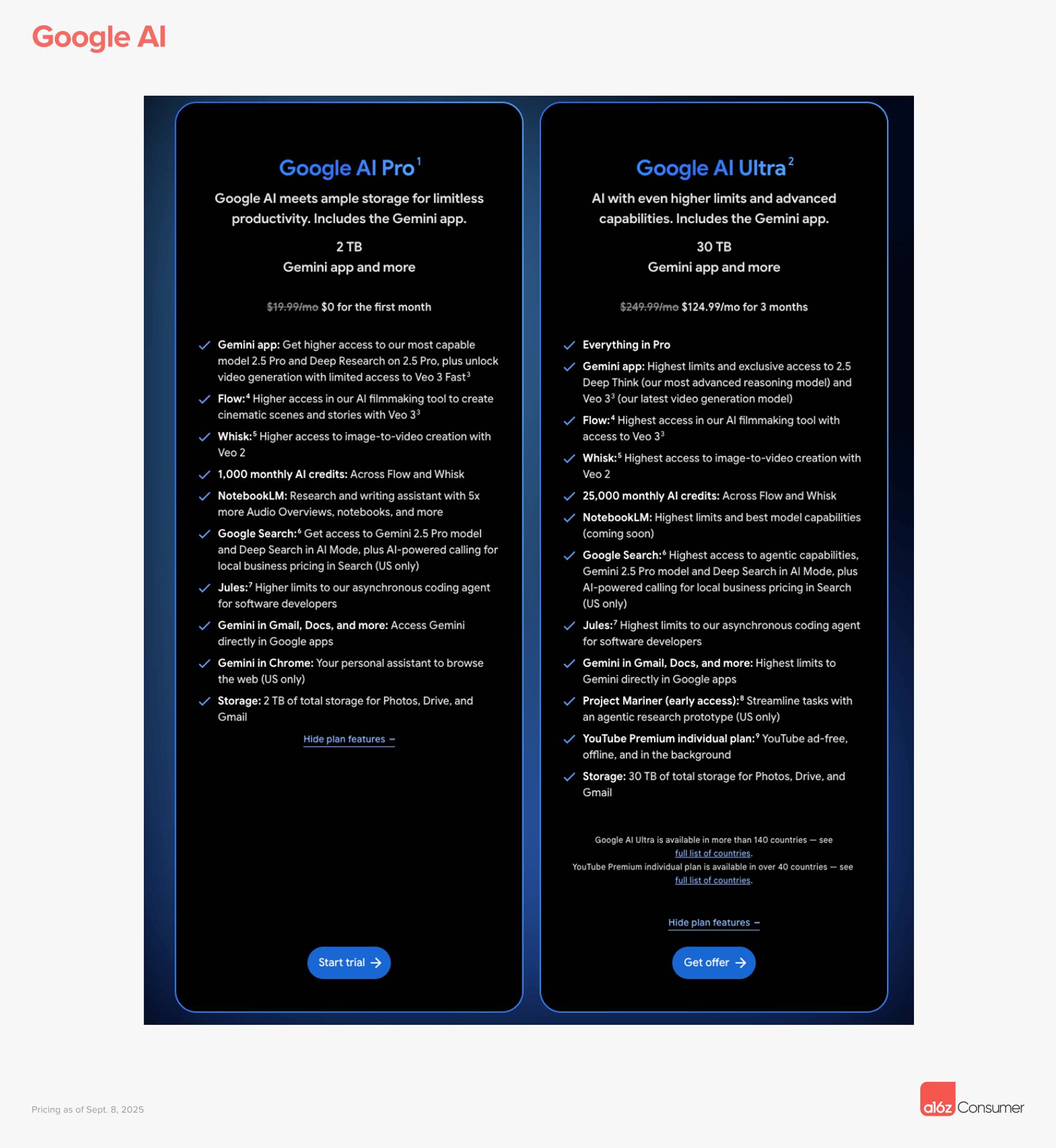
Krea的模式也很有趣,他们提供每月10-60美元的计划,基于预期使用量和训练作业,如果你超过了包含的计算单位,还可以购买5-40美元的额外积分包(有效期90天)。这种模式的精妙之处在于,它既为轻度用户提供了合理的入门价格,又为重度用户提供了扩展空间。
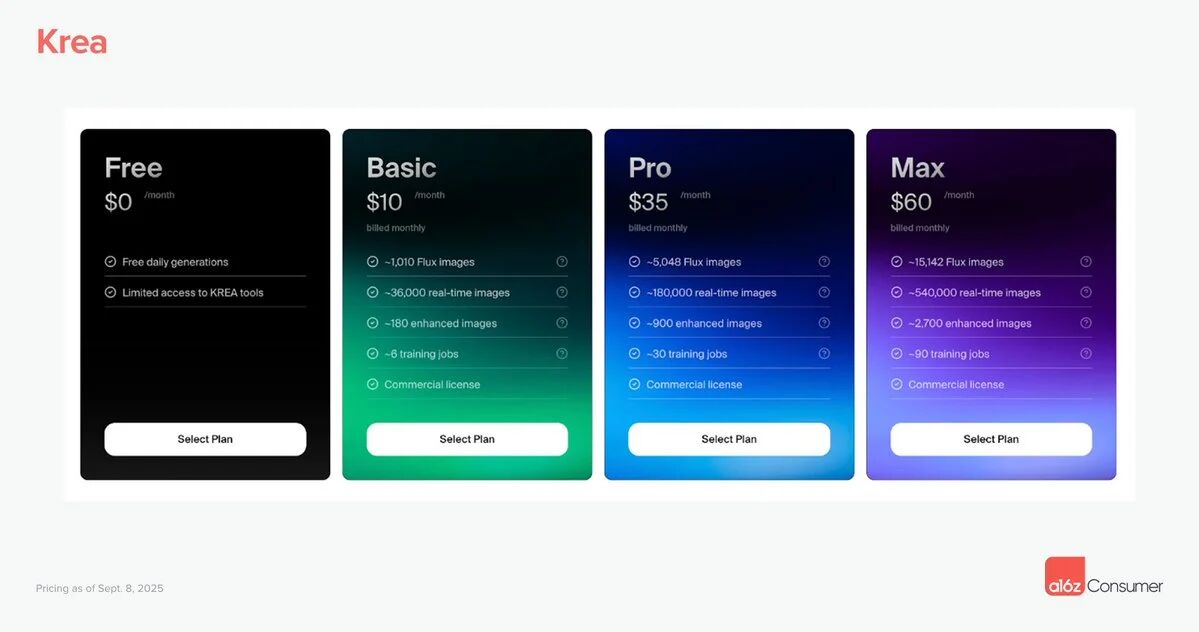
Grok的定价更是把这种策略推到了极致:SuperGrok计划每月30美元,SuperGrok Heavy计划每月300美元,后者解锁新模型(Grok 4 Heavy)、模型的扩展访问、更长的记忆和新功能测试。这种10倍的价格差异在传统消费级软件中几乎是不可想象的,但在AI时代却变得合理,因为不同用户的需求和价值感知差异巨大。
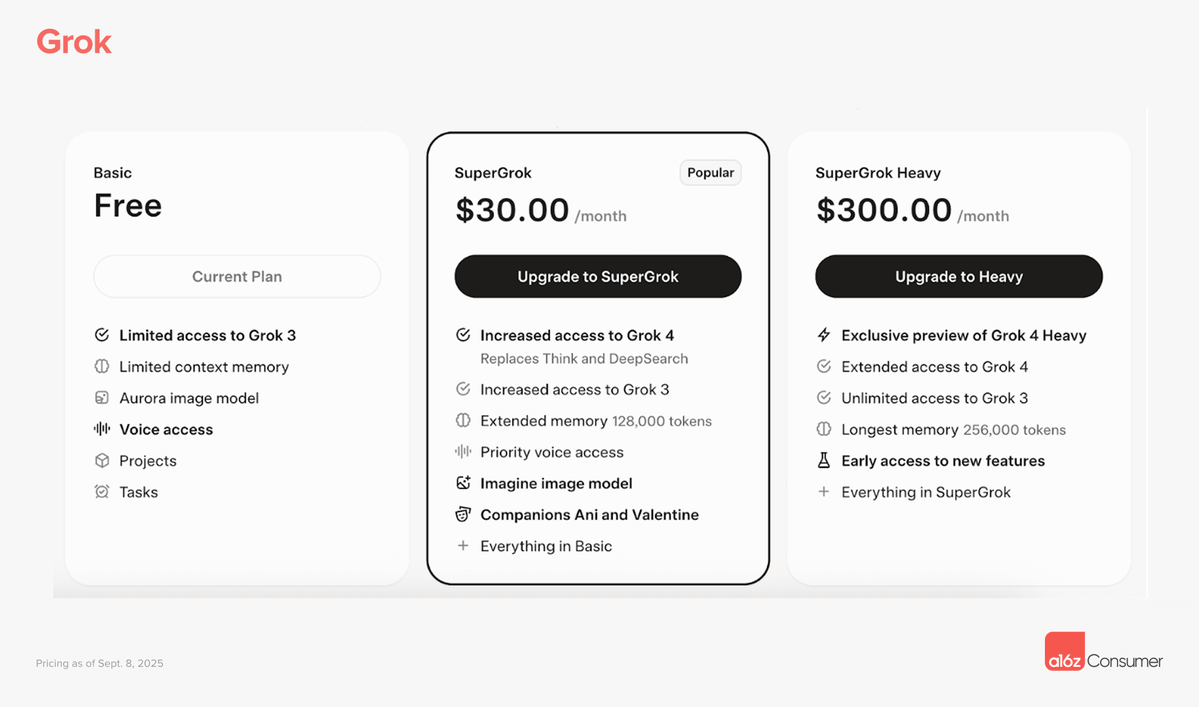
我认为这些模式的成功之处在于它们认识到了用户价值的多样性和动态性。不是所有用户都有相同的需求或支付能力,而同一个用户在不同时间的需求也会发生变化。通过提供灵活的定价选项,这些公司能够捕捉到用户价值的全部光谱。
Moore提到,一些消费级公司仅凭这种定价模式就实现了超过100%的收入留存率,甚至还没有考虑任何向企业的扩张。这说明了这种策略的强大之处。它不仅解决了传统消费级软件的流失问题,还创造了内在的增长机制。
从消费级到企业级的黄金桥梁
我观察到的另一个重要趋势是消费者将AI工具带入工作场所的速度前所未有。Moore在她的分析中强调了这一点:消费者积极地因为将AI工具引入工作场所而获得奖励。在一些公司,未能成为"AI-native"现在被认为是不可接受的。任何具有潜在工作应用的产品——基本上任何不是NSFW的产品——都应该假设用户会想要将其带入他们的团队,而且当他们可以报销时,他们会支付显著更多的费用。
这种转变的速度让我印象深刻。过去,从消费级到企业级的转变通常需要数年时间,需要大量的市场教育和销售努力。但AI工具的实用性如此明显,以至于用户自发地将它们引入工作环境。我见过很多情况,员工先个人购买AI工具,然后说服公司为整个团队购买企业版本。
从对价格敏感的消费者到对价格不敏感的企业买家的转变创造了巨大的扩张机会。但这需要基本的共享和协作功能,如团队文件夹、共享库、协作画布、身份验证和安全性。我认为这些功能现在已经成为任何有企业潜力的消费级AI产品的必备条件。
配备了这些功能,定价差异可以是巨大的。ChatGPT就是一个很好的例子,虽然它不被广泛认为是团队产品,但其定价突出了差异:个人订阅每月20美元,而企业计划范围从每用户25美元到60美元。这种2-3倍的价格差异在传统消费级软件中很少见,但在AI时代却变得常见。
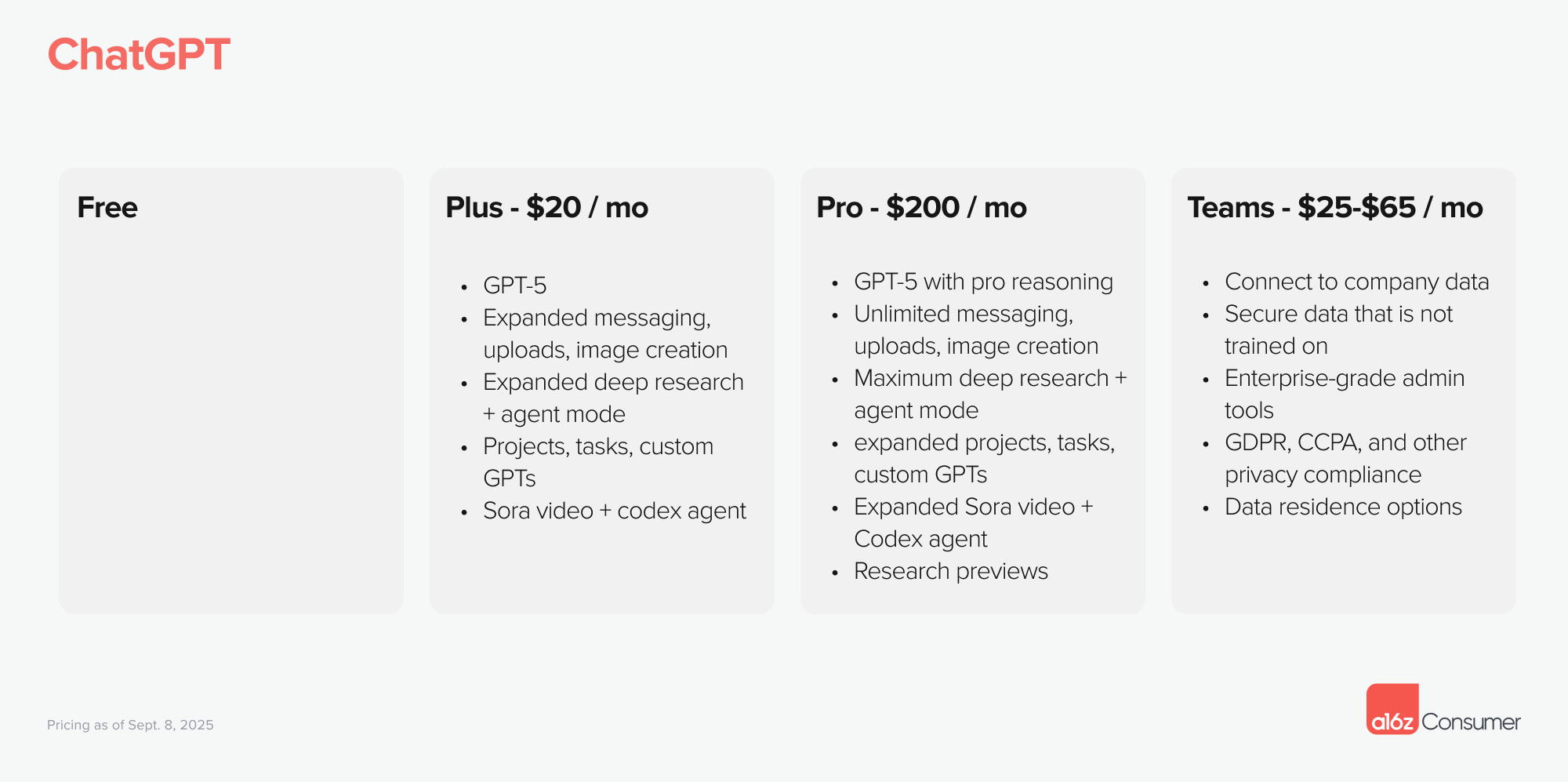
我觉得一些公司甚至将个人计划定价为盈亏平衡或轻微亏损,以加速团队采用。Notion在2020年有效地使用了这种方法,为单独用户提供无限免费页面,同时对协作功能收取激进费用,这推动了其最爆炸性的增长期。这种策略的逻辑是:通过补贴个人使用来建立用户基础,然后通过企业功能来实现盈利。
让我看看一些具体例子。Gamma的Plus计划每月8美元,用于去除水印——这是大多数企业使用的要求——以及其他功能。然后用户为添加到其工作空间的每个协作者付费。这种模式聪明地利用了企业对专业外观的需求。
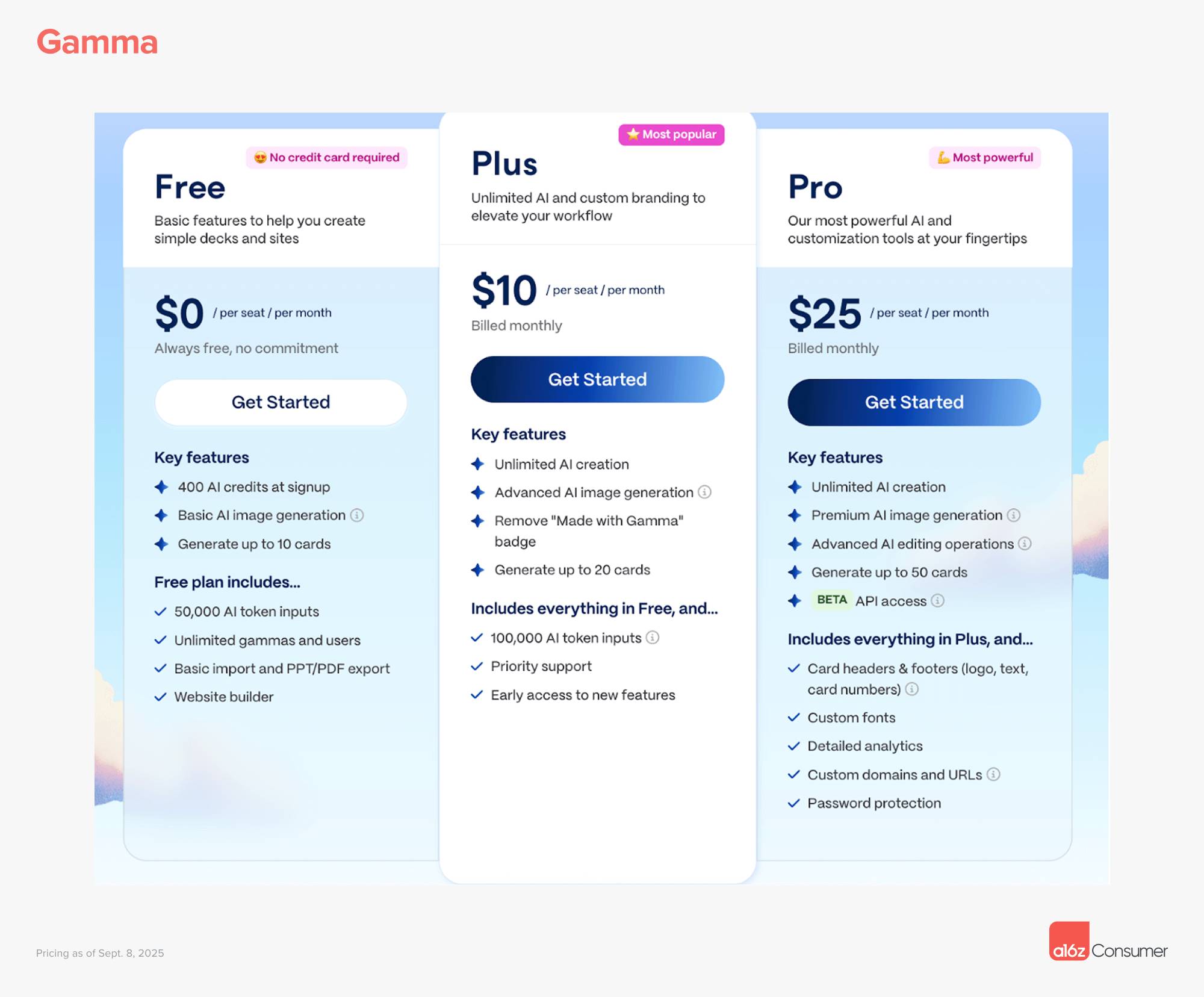
Replit为Core用户提供每月20美元的计划。团队计划从每月35美元开始,包括额外积分、查看器席位、集中计费、基于角色的访问控制、私有部署等。Cursor提供每月20美元的Pro计划和每月200美元的Ultra计划(使用量增加20倍)。团队用户为Pro产品支付每月40美元,配有组织范围的隐私模式、使用和管理仪表板、集中计费和SAML/SSO。

这些功能之所以重要,是因为它们解锁了企业级ARPU(每用户平均收入)扩张。我认为现在任何消费级AI公司如果没有考虑企业扩张路径,就是在错失巨大机会。企业用户不仅支付更高的费用,他们通常也更稳定,流失率更低。
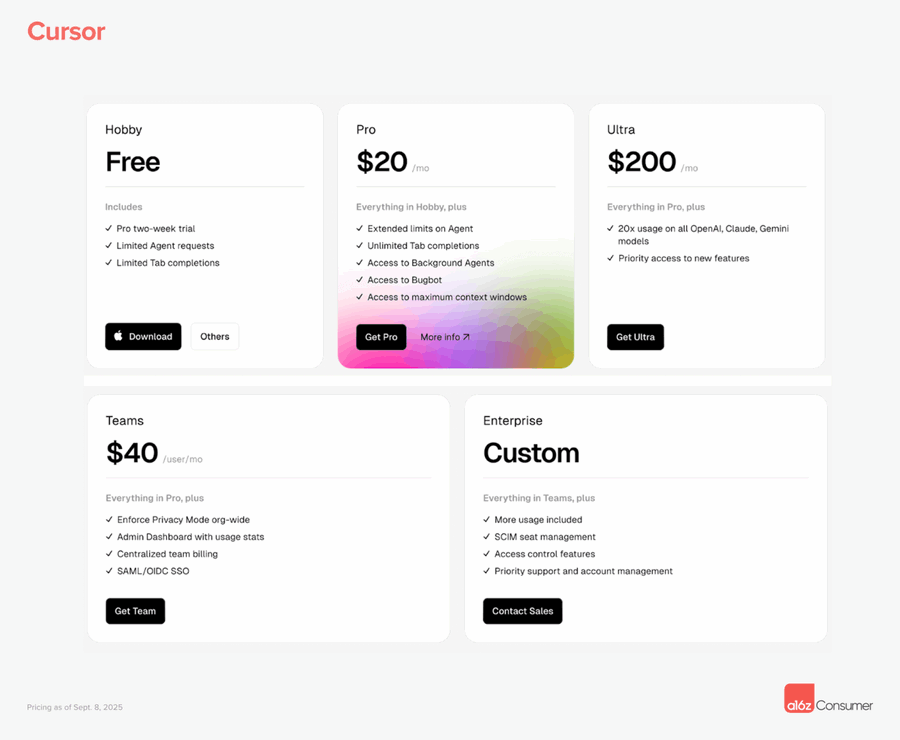
从第一天就投资企业级能力
Moore提出了一个看似反直觉但实际上非常明智的建议:消费级公司现在应该考虑在成立后的一到两年内雇佣销售主管。我完全同意这个观点,虽然这确实与传统的消费级产品策略背道而驰。
个人采用只能让产品走到一定程度;确保广泛的组织使用需要导航企业采购并完成高价值合同。这需要专业的销售能力,而不是简单地依赖产品的自然传播。我见过太多优秀的消费级AI产品因为缺乏企业销售能力而错失重大机会。
Canva成立于2013年,等了近七年才推出其Teams产品。Moore指出,在2025年,这种延迟不再可行。企业AI采用的步伐意味着如果你推迟企业功能,竞争对手将取而代之地捕获机会。这种竞争压力在AI时代被大大加速了,因为市场变化的速度比以往任何时候都快。
我认为有几个关键功能经常决定结果。在安全和隐私方面,需要SOC-2合规性、SSO/SAML支持。在运营和计费方面,需要基于角色的访问控制、集中计费。在产品方面,需要团队模板、共享主题、协作工作流。这些听起来可能很基础,但它们往往是企业采购决策的关键因素。
ElevenLabs是一个很好的例子:该公司开始时大量使用消费者,但迅速构建企业级能力,为其语音和对话代理添加HIPAA合规性,并定位自己为医疗保健和其他受监管市场提供服务。这种快速的企业化转型让他们能够抓住高价值的企业客户,而不仅仅依赖消费级收入。
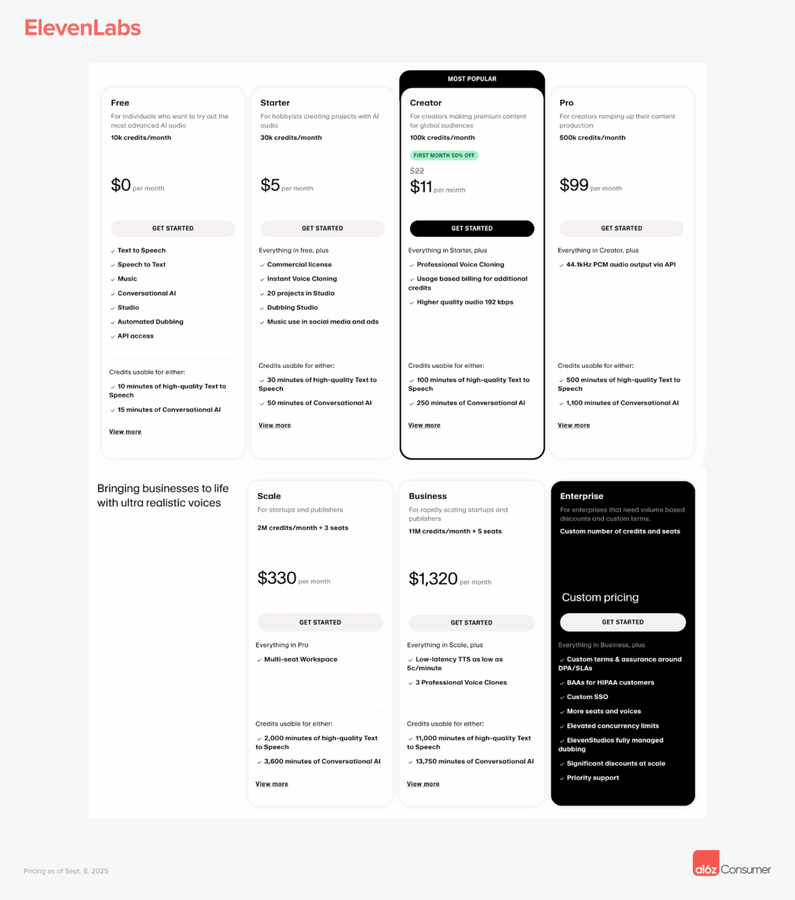
我观察到一个有趣的现象:那些早期就投资企业能力的消费级AI公司,往往能够建立更强的护城河。企业客户一旦采用了某个工具并将其集成到工作流程中,切换成本就会很高。这创造了更强的客户粘性和更可预测的收入流。
另外,企业客户还会提供宝贵的产品反馈。他们的需求往往更复杂,这推动产品向更高级的方向发展。我见过很多消费级AI产品通过服务企业客户而发现了新的产品方向和功能需求。
我对这种变革的深层思考
在仔细分析了Moore的观点和我自己的观察后,我认为我们正在目睹的不仅仅是商业模式的调整,而是整个软件行业基础架构的重构。AI不仅改变了产品的能力,还改变了价值创造和捕获的方式。
我觉得最有趣的是,这种变化挑战了我们对消费级软件的传统假设。长期以来,人们认为消费级软件天然低价、高流失、难以货币化。但AI时代的现实表明,消费级软件可以实现企业级的收入规模和增长率。这种转变的含义是深远的。
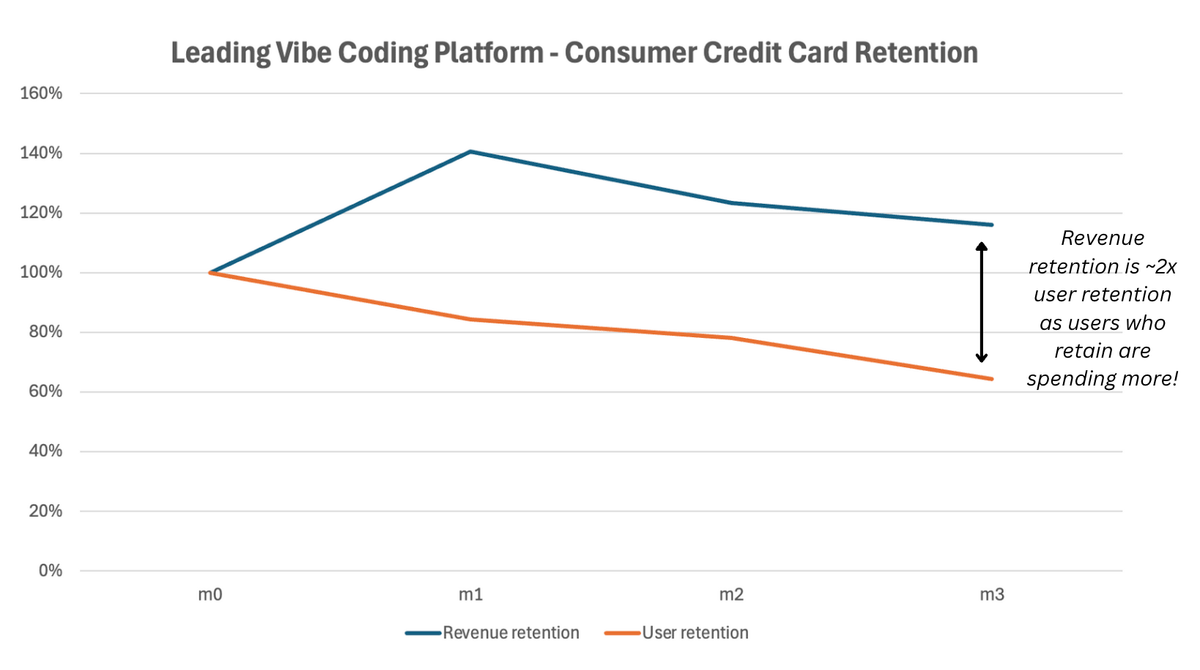
从资本配置角度看,这意味着投资者现在可以更早地向消费级AI公司投入更多资金,因为这些公司能够更快地实现有意义的收入规模。传统上,消费级软件公司需要等到达到巨大用户规模后才能有效货币化,但现在它们可以在相对较小的用户基础上就实现强劲的收入增长。
我也思考了这种变化对创业策略的影响。Moore提到,我们认为AI时代最重要的企业公司中很多可能都始于消费级产品。我认为这是一个非常深刻的洞察。传统的B2B软件创业路径通常涉及大量的市场研究、客户访谈和销售周期。而消费级开始的路径允许更快的产品迭代和市场验证。
这种方式的另一个优势是它创造了更自然的产品-市场契合。当消费者自愿使用并支付产品费用时,这是一个强烈的产品-市场契合信号。然后,当这些用户将产品带入工作场所时,企业采用就变得更加有机和可持续。
我还注意到一个有趣的竞争动态变化。在传统软件时代,消费级和企业级市场通常是分离的,有不同的参与者和策略。但在AI时代,这些界限变得模糊。一个产品可以同时在两个市场中竞争,这创造了新的竞争优势和挑战。
从技术角度看,我认为AI产品的这种双重性质(消费级易用性+企业级功能)推动了产品设计和开发的新标准。产品需要足够简单,让个人用户能够轻松上手,同时又足够强大和安全,能够满足企业需求。这种平衡并不容易实现,但那些做得好的公司将获得巨大的竞争优势。
我也思考了这种趋势对现有企业软件公司的影响。传统的企业软件公司现在面临来自消费级起家的AI公司的竞争,这些新进入者往往有更好的用户体验和更快的迭代速度。这可能会迫使整个企业软件行业提高其产品标准和用户体验。
最后,我认为这种变化还反映了工作方式的根本转变。远程工作、个人工具选择权的增加,以及对生产力工具的更高期望,都推动了消费级和企业级工具之间界限的模糊。AI只是加速了这种已经在进行的趋势。
未来的机会和挑战
虽然我对Moore描述的"Great Expansion"现象感到兴奋,但我也看到了一些需要注意的挑战和机会。
挑战方面,我认为竞争将会变得更加激烈。当成功的路径变得清晰时,更多的公司会尝试遵循相同的策略。那些能够建立强大差异化和网络效应的公司将在长期竞争中胜出。
从监管角度看,AI产品在企业环境中的快速采用可能会引起新的合规和安全挑战。公司需要确保他们的AI工具符合各种行业标准和法规要求。这可能会增加开发成本和复杂性,但也会创造新的竞争壁垒。
机会方面,我看到了巨大的创新空间。那些能够创造性地结合消费级易用性和企业级功能的公司将开辟新的市场类别。我也认为垂直化的AI工具有很大机会,针对特定行业或用例的深度优化可能比通用工具更有价值。
我还看到了数据和AI模型的网络效应机会。随着用户的增加和使用的深化,AI产品可以变得更加智能和个性化。这种数据驱动的改进可以创造强大的竞争优势,因为新进入者很难复制这种积累的智能。
从投资角度看,我认为这种趋势将继续吸引大量资本。但投资者需要更加精明地识别那些真正具有可持续竞争优势的公司,而不仅仅是那些短期增长快速的公司。关键将是理解哪些公司能够建立真正的护城河,而不仅仅是利用早期的市场机会。
最终,我相信Moore描述的"Great Expansion"只是AI革命的开始。我们正在重新定义软件的本质——从工具变成智能伙伴,从功能变成结果。那些能够抓住这种转变并成功执行的公司将建立下一代的技术巨头。这不仅是商业模式的创新,更是对人与技术关系的重新想象。我们正处在一个激动人心的时代,软件正在变得更加智能、更加有用,也更加不可或缺。
免责声明:本文章仅代表作者个人观点,不代表本平台的立场和观点。本文章仅供信息分享,不构成对任何人的任何投资建议。用户与作者之间的任何争议,与本平台无关。如网页中刊载的文章或图片涉及侵权,请提供相关的权利证明和身份证明发送邮件到support@aicoin.com,本平台相关工作人员将会进行核查。




